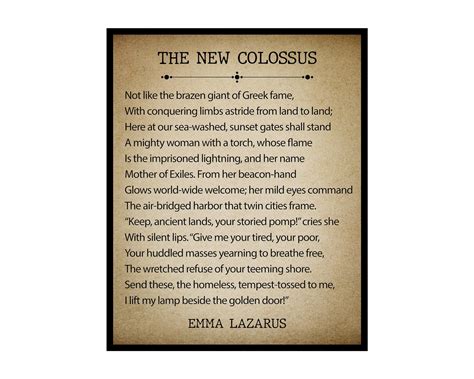The Statue of Liberty, with its iconic torch and tablet, is one of the most recognizable landmarks in the world. However, the true significance of this monument lies not only in its visual grandeur but also in the poetic ideals it represents, as enshrined in Emma Lazarus's sonnet, "The New Colossus." This poem, written in 1883, was a donation to an auction to raise funds for the pedestal upon which the Statue of Liberty stands. Here are five key facts about "The New Colossus" that underscore its enduring importance:
Key Points
- The poem "The New Colossus" was written by Emma Lazarus in 1883 to raise funds for the construction of the pedestal for the Statue of Liberty.
- The sonnet is inspired by the Statue of Liberty and reflects the ideals of freedom and opportunity that the monument represents.
- Emma Lazarus was a descendant of Sephardic Jews who had fled persecution in Portugal and settled in the United States, influencing her perspective on freedom and refuge.
- The poem gained widespread recognition and became a symbol of American ideals after its inscription was added to the pedestal of the Statue of Liberty in 1903.
- The poem's themes of inclusivity, freedom, and the welcoming of immigrants have made it a central piece of American cultural heritage, particularly relevant to discussions on immigration and national identity.
The Historical Context of “The New Colossus”

Understanding the historical context in which “The New Colossus” was written is crucial to appreciating its significance. In the late 19th century, the United States was experiencing a massive influx of immigrants, many of whom were fleeing persecution, poverty, or both in their home countries. The Statue of Liberty, a gift from France to the United States, was dedicated on October 28, 1886, and was intended to symbolize the principles of freedom and democracy. However, the statue’s pedestal was funded through public donations, leading to the auction where Lazarus’s poem was first introduced.
Emma Lazarus and Her Inspiration
Emma Lazarus was an American poet of Jewish descent, known for her strong advocacy for the rights of Jewish immigrants and her dedication to social justice causes. Her background and experiences significantly influenced her writing, including “The New Colossus.” The poem’s themes of hope, freedom, and the welcoming of the oppressed to the shores of America reflect not only the ideals of the Statue of Liberty but also Lazarus’s own family history and her commitment to the cause of Jewish refugees. The famous lines, “Give me your tired, your poor, / Your huddled masses yearning to breathe free, / The wretched refuse of your teeming shore. / Send these, the homeless, tempest-tossed to me, / I lift my lamp beside the golden door!” have become an emblem of American values, inviting the world’s oppressed to find refuge in the United States.
| Year | Event |
|---|---|
| 1883 | Emma Lazarus writes "The New Colossus" for an auction to raise funds for the Statue of Liberty's pedestal. |
| 1886 | The Statue of Liberty is dedicated on October 28. |
| 1903 | The poem "The New Colossus" is engraved on a bronze plaque and mounted inside the pedestal of the Statue of Liberty. |

The Impact and Legacy of “The New Colossus”

The impact of “The New Colossus” extends far beyond its role as a fundraiser for the Statue of Liberty’s pedestal. After its inscription was added to the pedestal in 1903, the poem gained widespread recognition and became an integral part of American cultural heritage. It has been referenced, paraphrased, and alluded to in countless speeches, writings, and discussions about immigration, freedom, and national identity. The poem’s message of inclusivity and welcome has resonated with generations of Americans and immigrants alike, symbolizing the country’s aspirations to be a beacon of hope and freedom for the world.
Challenges and Controversies
Despite its iconic status, “The New Colossus” and the ideals it represents have not been without challenge. The poem’s call for inclusivity and the welcoming of immigrants has been at odds with periods of anti-immigrant sentiment and policy in the United States. Additionally, the historical context of the poem, written during a time when immigration policies were less restrictive, has led to discussions about the poem’s relevance to contemporary immigration debates. Nonetheless, “The New Colossus” remains a powerful symbol of American ideals, prompting reflection on the nation’s role as a refuge for the oppressed and its commitment to freedom and opportunity for all.
What was the original purpose of "The New Colossus"?
+"The New Colossus" was written by Emma Lazarus to raise funds for the construction of the pedestal of the Statue of Liberty through an auction.
When was "The New Colossus" inscribed on the Statue of Liberty's pedestal?
+The poem was inscribed on a bronze plaque and mounted inside the pedestal of the Statue of Liberty in 1903.
What are the central themes of "The New Colossus"?
+The central themes include freedom, inclusivity, and the welcoming of immigrants, reflecting the ideals of the Statue of Liberty and American democracy.
In conclusion, “The New Colossus” is more than just a poem; it is a profound expression of the values that underpin American society. Its message of hope and inclusivity continues to resonate today, serving as a beacon of freedom and opportunity for generations of immigrants and Americans alike. As a cultural icon, it reminds us of the importance of preserving and promoting the ideals of freedom, democracy, and the pursuit of a better life for all.
